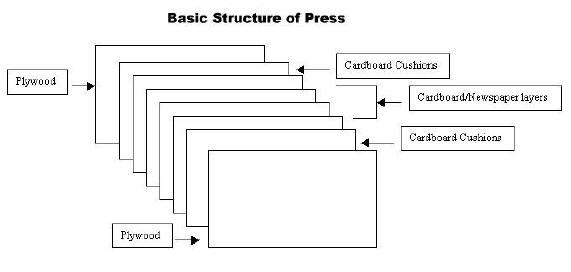|
Make a
Plant/Flower Press for Fun & Education
Kathy Green-Adelsberger
Adams County
Master Gardener
 Looking for a project
that is fun and educational? If you love searching for
wild flowers at the first hints of spring and cannot
help admiring beautiful plants and flowers throughout
the growing season, making a plant/flower press is a
project you will love. Looking for a project
that is fun and educational? If you love searching for
wild flowers at the first hints of spring and cannot
help admiring beautiful plants and flowers throughout
the growing season, making a plant/flower press is a
project you will love.
In this 'Part One' of
a two-part article, you will learn how to make a very
attractive, durable, long-lasting plant/flower press
in a few easy steps. You can customize your
plant/flower press to your liking with some creativity
on your part. Next week in 'Part Two' we will explore
how to properly collect plants/flowers, important
rules for collecting, how to press plants/flowers so
they last a long time, and the almost unlimited things
you can do with your pressed treasures afterwards.
Plant/flower presses
have been around for a very long time. For centuries
at herbariums all over the world, plant specimens have
been collected and pressed for indefinite storage
using plant/flower presses. Herbarium collections look
way beyond the aesthetics of a plant. They capture
more of the science of plants by collecting every
possible aspect of the plant such as leaves, stems,
root systems, as well as data on habitat and
environment. This information is extremely valuable
for identification and taxonomy purposes in the
botanical world.
To make a
plant/flower press, you need the following tools and
supplies: two ¼ to ½ inch thick pieces of plywood cut
to approximately 15 x 17 inches, several strong
corrugated cardboard sheets cut to a fraction smaller
than the plywood pieces, several sheets of newspaper,
clear mailing tape, belts or locking straps and your
creativity.
Before you begin, it
helps to get an overview of what the plant/flower
press looks like assembled and how it works. The two
pieces of plywood are the outer layers of the press.
They are important for weight and structure because
you will be putting tremendous weight on the layers of
plants inside.

Just inside each
plywood piece is a thick layer of 4 corrugated
cardboard pieces taped together to make additional
cushioning for the inner layers of plants/flowers. The
inner layers consist of folded newspaper with plant
specimens carefully arranged inside, each separated by
single sheets of corrugated cardboard. Once you have
all the layers of plants/flowers arranged in the
newspapers and separated by the cardboard, the plywood
pieces hold it all together. You then place locking
straps around the entire press and pull them as
tightly as possible. Below is a simple schematic of
how the plant press looks with its layers:
Starting with the
outer layers of your plant/flower press, which are the
two pieces of cut plywood, you can customize your
plant press by letting your creativity soar. There are
virtually unlimited options for individualizing your
plywood pieces. If you enjoy wood-carving or burning,
create a unique design on the outer side of your
plywood pieces. If you want more color, paint a
beautiful design on the plywood or apply stickers or
scrapbook embellishments, but remember to seal
everything with a clear polyurethane varnish. It is
important to thoroughly seal the two plywood pieces so
that they have lasting strength and beauty. Be sure to
follow the instructions indicated on the particular
product you choose to use.
Under the cut plywood
covers are the two inside cushions and inner layers of
the press. They are made up of four pieces each of
corrugated cardboard taped together lengthwise and
crosswise with clear mailing tape. All cardboard
pieces should be just a fraction smaller than the
plywood, so they do not stick outside the plywood.
There are different grades of corrugated cardboard.
Double corrugated cardboard provides more support, but
single corrugated board can also be used if it is
strong.
Make sure you have
plenty of additional pieces of corrugated cardboard
for separating the plants/flowers that will be encased
in the sheets of newspaper. Cut several more single
sheets of cardboard the same size as your cushion
sheets. The more of these single sheets you have, the
more plants/flowers you can press at one time. These
separator sheets will be placed between the
plant/flower specimens you mount in a newspaper
blotter. The newspaper blotter is simply a sheet of
any newspaper you choose to use. You can also use
blank newspaper available from most newspaper offices.
More on arranging your plants/flowers in the press in
next week's article.
You now have all the
components of your plant press with one exception--you
need plants and flowers.
The list of flowers
that dry well is a large one. A simple rule to follow
is that the thinner the flower the faster it will dry,
thus preserving its color better. Some flowers that
dry well include ageratum, alyssum, buttercup,
chrysanthemum, clematis, columbine, cosmos, crocus,
daisy, fern, geranium, hydrangea, larkspur, lily of
the valley, marigold, pansy, Queen Anne’s lace,
salvia, statice, sweet pea, violets, violas and
zinnia. It is best to pick or cut your plants or
flowers on a dry day. Pick them in the morning, as
soon as any dew has dried. Gather them just before
they reach the full bloom stage. Remember some flowers
open more as they dry.
Important Rules and Guidelines for Collecting
Plants
Never collect plants from parks, botanical gardens or
other private properties where plant collecting is
prohibited. Never collect plants that are considered
exotic, threatened, endangered or protected. Collect
only from areas where at least 20 of the plants are
growing and then only take one plant or plant part of
the species you are collecting. Collect only plants
native to the region. Be careful not to scatter seeds
when collecting invasive plants. Do not take plants or
plant parts you do not plan to press. If you are
collecting flowers, cut only the flower parts and
leave the rest of the plant behind. Be careful not to
step on or damage surrounding plants and always
remember to get permission to collect plants from
others’ properties.
If you see a plant that you should not collect,
capture it in a photograph instead. Use a sharp knife
or trowel to carefully dig up the entire plant.
Collect plants that have their flower parts and roots,
if possible. Avoid plants or parts of plants that are
too thick to slice or manage in the plant press.
Handle the plant very carefully, trying to maintain
the entire structure. Collect enough stems and leaves
to show upper and lower sides and arrangement. Keep
the plants in a plastic bag wrapped in moist newspaper
until you can prepare them for pressing, but not
longer than 4 hours. Include some type of information,
notes on the environment, soil, etc., with the plant
for later identification. Avoid collecting plants that
are damaged or diseased and be careful of poisonous
plants.
Steps for Mounting Plants in the Press
When you are ready to press your plants, and hopefully
as soon after collecting them as possible, gently wash
all soil from the plants’ roots, then shake off and
blot excess moisture. If the specimen is too rigid to
manage, let it sit for a few minutes until it wilts,
but do not let it dry out or the leaves will curl.
Start from the bottom of the plant press and work
upward, having the bottom plywood structure in place,
then the bottom liner, then one separator, then a
double newspaper blotter folded in half.
Carefully arrange each plant inside a double folded
newspaper blotter in your plant press. Arrange leaves
and flowers so that you have front and back views.
Arrange flowers so that reproductive parts are
visible. Trim off redundant parts of the plant if
necessary to make it more manageable in the press, but
keep good representatives of all parts. Bend the
stem(s) into a V-shape if necessary to fit it within
the newspaper blotter. Make a note in the margin of
the newspaper blotter identifying each plant for
labeling and displaying later. Set any seeds, large
fruits or nuts aside for separate handling and
displaying.
Once the plant is arranged on one side of the
newspaper blotter, continue holding plant parts in
place while carefully folding the other side over the
plant. Never glue or tape plants or parts to the
newspaper. Place a cardboard separator over the folded
newspaper and prepare the next newspaper for mounting
another plant. Continue adding to and arranging plants
within the newspaper blotters, adding a cardboard
separator between each. Once all of the plants are
mounted in the plant press, add the top cushion liner,
then the top plywood structure. Wrap the belts around
the plant press crosswise, tighten as much as possible
and lock. Hint: stand on the press or have someone
stand on it while you tighten and lock it to squeeze
as much moisture out of the plants as possible.
Place the plant press in an area where dry warm air
circulates. Never place in humid areas. It is too
dangerous to try to dry in an oven. After a couple of
days, check the plants and determine if the newspaper
blotters are too moist; if so, replace them wit dry
blotters and retighten the belts as much as possible.
The plants will be pretty dehydrated by now and very
limp, so you may have to carefully reposition them in
the dry blotters. Check the press again after another
couple of days. When plants are completely dry,
carefully remove them for displaying. If some plants
or plant parts are not completely dry, continue to dry
them in the press for another 2 to 3 days and check
again. The simpler the plant or flower, the fewer
times you will have to repeat this drying process.
Displaying Pressed Plants
There’s more art than science to displaying pressed
flowers. Be patient; practice makes perfect. Be
careful not to damage pressed plants; they are
extremely fragile. Do not try to re-shape plants once
they are pressed; they will break or tear.
Pressed plans may be mounted on clean, acid-free paper
by gently gluing (with diluted glue), taping,
laminating, placing into photo albums or mounting on
herbarium paper. The paper should be large enough to
accommodate the entire plant and its parts without
overcrowding or hanging off the sides. Create a label
for each plant including information about genus,
species, common name, where collected, habit,
environment, soil, etc. Glue or affix the label to the
sheet for display with the pressed plant. Label the
plant parts, if you desire; it’s a great way to learn.
Keep your pressed plants in binders, photo frames,
photo albums, scrapbooks, display boxes—whatever
container will keep the plants intact and away from
light, heat and moisture.
There are unlimited ways to use pressed flowers. They
are great arranged and mounted in photo frames, used
in greeting cards or decoupaged onto wood--just to
name a few uses. Let your creativity soar and design
beautiful lasting collectibles for the special people
in your life.
If you are interested
in buying a plant press kit, they are available while
supplies last at the Master Gardener office of the
Adams County Extension Center in Gettysburg, PA. The
cost is $25 per kit. Each kit includes two unfinished
plywood pieces for you to customize, two 4-piece
cardboard cushions, some single corrugated cardboard
sheets and an instruction booklet. Contact Mary Ann
Ryan, Master Gardener Coordinator, at 334-6271.
Read other articles
by
Kathy Green-Adelsberger |